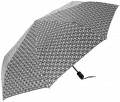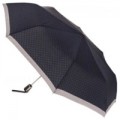Spoke material
The material from which the spokes of the umbrella are made. It may differ from the frame material (see the relevant paragraph), which is why this parameter is given separately.
—
Steel. One of the most common knitting needle materials. In modern umbrellas, different grades of steel can be used, differing in price and quality; usually, this moment directly depends on the price category of the umbrella. However, anyway, this material is strong enough, resilient, reliable and durable, and is relatively inexpensive. The main disadvantage of steel can be called a relatively large weight.
—
Aluminium. Compared to steel, aluminium is distinguished, on the one hand, by its lower weight, and, on the other hand, by its relatively low strength. As a result, it is relatively rare, mainly in children's umbrellas and low-cost "adult" models.
—
Fibreglass. A material based on a fibre of thin glass threads. Differs in rather high durability and reliability. However, the main advantage of this material can be called the ability to bend well without damage, which allows such knitting needles to normally endure turning the dome inside out. This is especially important for
storm umbrellas(see above), although it will be useful for a regular umbrella. However, such knitting needles are more expensive than the same steel ones.
...>
— Fibreglass. Composite material made of glass fibre filled with plastic. It is similar in properties to the fibreglass described above, however, on the one hand, it is cheaper, on the other hand, it is somewhat inferior to it in terms of performance, including the same flexibility.
— CFRP. Composite carbon fibre material with plastic filler. With a small weight, carbon fibre is highly durable, however, it also costs accordingly, which is why it is relatively rare.Dome diameter
The diameter of the umbrella dome when unfolded. The larger the diameter of the dome, the more reliably it will protect you from rain and the easier it will be to place one more person under the umbrella. On the other hand, a wide umbrella can be uncomfortable in tight spaces — for example, in the flow of pedestrians on a busy street — and when folded it will take up more space. Therefore, it does not always make sense to choose the largest of the available options.
The minimum diameter for an "adult" umbrella (see "Destination") is considered to be about 80 cm. Most models are in the range of 90 – 110 cm — this provides a good degree of protection with ease of movement. And in
the largest modern products, the diameter of the dome can reach 150 cm.
Length (folded)
The length of the umbrella when folded. For the decomposed one, this parameter is not specified, because is not critical, but when transporting a closed umbrella, it is the length that is the most important dimension.
The length of cane umbrellas (see "Type") is, by definition, the same when open or closed; most often it is 60 – 90% of the dome diameter (see above). But folding models of the same diameter can vary markedly in length, and here the choice depends on the situation: on the one hand, more compact umbrellas are more convenient to carry, on the other hand, they are less reliable and more complex in design, and also cost more.
Dome material
The material of the dome is a canopy stretched between the spokes of the umbrella.
— Polyester. Synthetic material, the most popular among modern umbrellas. It has good strength and density, as well as water-repellent properties (although in its pure form it still gets wet sooner or later); in addition, it is resistant to temperature extremes and ultraviolet radiation. It is also worth noting that various additives can be used in polyester domes, which can significantly change the appearance and properties of the fabric — for example, it can easily be given a resemblance to silk or satin, provide additional water-repellent properties, etc. Therefore, we can say that such umbrellas are very diverse, and the properties of the dome largely depend on the price category of the product.
— Nylon. Synthetic material, somewhat similar to polyester, but cheaper — and in every sense: it is inexpensive, but it loses in a number of characteristics. In particular, nylon is not so strong and reliable, besides it is less pleasant to the touch, and after drying it can “sit down”. It is used mainly in low-cost models of umbrellas.
— Eponge. Cotton or silk fabric, characterized by an original surface texture — it resembles a sponge (hence the name — from the French eponge). However, unlike a regular sponge, pongee practically does not absorb moisture — on the contrary, it has excellent water-repellent properties and dries quickly. At the same time, the fabric has a...n original appearance, is pleasant to the touch, and its price is low, which makes it possible to use this material even in relatively inexpensive umbrellas.
— Silk. Silk provides the product with a luxurious appearance, but loses to other materials in terms of strength, and also gets very wet. As a result, this material is usually used in umbrellas from the sun (see "Application"), and among the "rain" is almost never found.
— PVC film. Distinctive features of a film based on polyvinyl chloride (PVC) are complete imperviousness, as well as transparency. This allows you to create on its basis not only classic umbrellas, but also the so-called birdcage ("birdcage") — models with a high dome, covering not only the head, but also the shoulders.
— Jacquard. Waterproof fabric, usually synthetic, having a so-called jacquard weave. Due to this, a specific texture pattern is visible on the surface of the dome, giving it an original appearance. On the other hand, jacquard is quite difficult to manufacture, and therefore expensive.
— Satin. Cotton or silk fabric with an additional water-repellent impregnation, having a satin weave. This weave gives a rather dense surface with a characteristic sheen, giving it a pleasant appearance. Satin is used mainly in design models of umbrellas, on the domes of which various patterns are applied.
— Polyamide. Polyamides is the general name for a number of synthetic fibers, in particular, capron and nylon (see above). They have good water-repellent properties, but the performance characteristics (durability, resistance to stretching, etc.) can be different — depending on the price category of the umbrella.
Weight
Total weight of the umbrella.
All other things being equal,
lighter umbrellas are more convenient to carry (both in the open and closed positions). On the other hand, such products are less reliable and/or more expensive than relatively heavy models of similar design and size. We also note that in some cases, significant weight can be an advantage. For example, in a strong wind, a massive umbrella does not “tear from your hands” as much, and when released, it does not fly as far as a lighter one.

